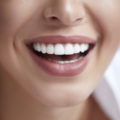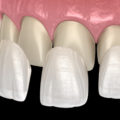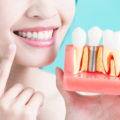In today’s world, you don’t need to be a celebrity to have a smile noteworthy of Hollywood. The art of cosmetic dentistry has come a long way since 1928 when Charles Pincus carried out the very first attempt at dental veneer placement.
Nowadays, dental veneers are one of the most popular solutions to a range of dental issues — whether they’re cosmetic or related to your oral health. In fact, the global dental veneer market comes in at over $1.55 billion, indicating the popularity of this procedure — specifically, porcelain veneers.
Want to learn what all the fuss is about? Check out this guide on dental veneers for everything you need to know.
Dental Veneers: What Exactly Are They?
If you’re thinking about a dental veneer procedure, it’s imperative that you know what to expect, first. And with that, let’s take a look at what dental veneers actually are:
- They are tooth-coloured, thin coverings that fit over your existing teeth
- They’re comprised of resin or porcelain materials
- They’re placed over visible parts of your tooth, only
The best thing about veneers is that they’re designed and manufactured to match the natural shape and colour of your teeth. So, in short, their general purpose is to improve the original version of your teeth. However, dental veneers can also help with improving dental health, overall.
It’s worth noting that dental veneers are not a solution to underlying oral health issues such as tooth trauma or decay. This is something you’ll need to remedy first, before opting for dental veneers.
You can choose to place veneers on multiple or singular teeth, depending on the imperfections you wish to correct. The most popular position for dental veneers is usually the most visible teeth at the front of the mouth.
While you can choose how many veneers you’d like, it’s also up to your dentist’s discretion on what would work best for your oral health.
Tooth Flaws Remedied by Dental Veneers
As mentioned, underlying issues such as tooth decay, gum disease, and tooth trauma are all serious oral health problems you must address before you go ahead with dental veneers. Unfortunately, they cannot resolve these issues.
But what dental veneers can do is remedy certain tooth flaws. Here’s what they can fix:
- Stained or discoloured teeth
- They can cover up dark fillings
- Veneers can fill in gaps between your teeth
- They can cover and reinforce chipped, cracked, or worn-down teeth
- Dental veneers are a good option for irregularly shaped teeth, shaping a straighter smile
There are a number of different veneer materials on the market today. Some are better options for transforming your smile or rectifying certain tooth flaws. Here are some of the most common types of veneers:
Porcelain Veneers
This is undoubtedly one of the most popular materials used for dental veneers today. This is because porcelain is exceptionally strong and hardy, and also offers the most natural tooth-like look and feel.
Porcelain veneers consist of a thin shell of porcelain that’s placed over your natural tooth. Despite how thin the material is, it’s far more durable and long-lasting than any other veneer material on the market.
For this reason, they are a little more expensive than other material types — but as the saying goes, you always get what you pay for. Porcelain veneers can last up to 20 years with good oral hygiene practices and regular dental check-ups.
Porcelain veneers are also a good option if you struggle with very sensitive teeth or gums.
Composite Veneers
The next best option in terms of veneer materials is composite resin. These veneers include a thin layer of tooth-coloured composite that binds to the surface of your natural teeth.
While the thickness of composite veneers can vary, they are also very durable, natural-looking, and comfortable. The lifespan of these types of veneers is between 7-10 years with good oral hygiene in place.
Composite veneers are the more affordable option and the procedure is far quicker than the placement of porcelain veneers. Minor chips, cracks, and breaks in composite veneers are also easy to fix.
What To Expect From the Procedure
Despite the fact that the purpose of dental veneers is largely cosmetic for most people, there is a degree of preparation that’s necessary for the best possible outcome.
In other words, your dentist needs to ensure that they get the ideal fit, shape, and shade of veneer to match the look and feel of your natural teeth. There’s even some preparation that goes into ensuring you’re choosing veneers for the right reason.
To add to this, your dentist will also do an extensive check-up on your dental health to ensure you don’t have any pre-existing conditions that need addressing. For the best outcome, you need to have a good level of oral health, first.
Once your dentist analyses your teeth and determines you’re a good dental veneer candidate, preparation begins. Here’s what to expect from the preparation stage:
- Your dentist snaps a few pictures of your teeth and smile and analyses the images for the best tooth shape and shade
- After this, they’ll take an impression of your teeth and then use this to create a mock-up of the best veneers for your smile
- You are then allowed some time to preview the mock-up and discuss the outcome with your dentist
- You also have the option of having your existing teeth whitened (the teeth that aren’t receiving veneers)
Once your dentist completes all of this preparation, they’ll move on to the pre-procedure. In some cases, this might be the next day or a couple of days later. In other cases, it could be on the same day. Here’s what the beginning stages of the veneer procedure look like:
- Your dentist prepares your teeth by removing the top layer of enamel (no more than 0.7mm depth)
- After that, they’ll take another impression of your teeth and send it off to the lab
- You’re then fitted with temporary veneers as per the mock-up that was created in the preparation stage
You’ll have a chance to test out the trial veneers and make changes to anything you’re not happy with. Most of the time, you’re sent home to trial out the veneers. The general wait time for your permanent veneer fitting is about 2-4 weeks.
When your veneers are ready, the bonding stage begins:
- Your dentist will remove your temporary veneers
- They’ll then do a test fit of your new veneers to ensure everything sits in place, as it should
- After that, your dentist applies a bonding agent to the veneers, which they then place on your teeth
- The veneers cure and bond under a specialised light for a few minutes (approximately one minute per tooth)
The entire procedure finishes off with a final clean of your teeth and the removal of excess bonding material.
What Is the Cost of Veneers?
It’s worth noting that dental veneers are something you invest in. They are by no means a low-cost option when it comes to cosmetic dentistry, but they are certainly worth the investment over the long term.
The cost of dental veneers varies widely across Australia. Some of the most important factors that influence what you’ll pay are the region you live in, the number of veneers you choose, the type of veneer material you choose and the expertise of your dentist.
In Perth, the average cost of a single porcelain veneer varies from $1,200-$1,800. The cost also depends on the location of the tooth. While composite veneer prices range from $350-$600 per tooth.
Many dental practices offer financing plans and insurance cover, so it’s worth asking about how your dental practice can assist you.
The Pros of Dental Veneers
Every cosmetic dental procedure has its pros and cons. With dental veneers, it’s no different. Here’s what you ought to know about the advantages and drawbacks before you make your decision and pay good money for veneers. Let’s take a look at the benefits, first:
- You get what you pay for. Veneers are durable and last a long time if you take care of them as recommended
- There’s nothing superficial about them. They look natural, uniform, and improve the appearance of your smile
- Veneers are comfortable in the mouth, you won’t even notice you have them after the first couple of days. The procedure itself is also completely pain-free
- Among other dental procedures, veneers are one of the most affordable when compared to dental crowns and bridges
- They help to reduce tooth sensitivity if that’s something that bothered you before as the veneers cover a large majority of the tooth
- Dental veneers can improve your bite by rectifying gaps between teeth which can cause issues when eating/chewing your food
It’s also worth mentioning that dental veneers can do absolute wonders for your self-confidence. If you are self-conscious about your smile because of damaged teeth, veneers can resolve this. This, in itself, can improve many other facets of your life too.
The Cons of Dental Veneers
There is always some risk involved with every dental procedure, whether it’s cosmetic or necessary for your oral health. Here are a few potential drawbacks worth knowing about, despite them being rare:
- There is the potential for infection if veneers are not placed correctly. Your underlying tooth could become inflamed and this could lead to a gum infection
- Veneers could become stained if you fail to stick to a good oral hygiene regimen, especially in the first few weeks after your procedure
- Dental veneers can cause tooth sensitivity in rare instances when consuming hot or cold foods. If this is the case, you’ll need to discuss the issue with your dentist
- Replacement costs are quite high. If you bite down too hard on something there’s a chance you could chip or break a veneer. You might need a replacement and this can get expensive
- There is a chance of tooth decay forming underneath the veneer if you do not have a proper oral hygiene regimen
Finally, there is also the odd occasion that you might have an allergic reaction. Some people might have an allergy to dental porcelain and not know about it. But overall, all of the above instances do not happen often.
Dental Veneer Maintenance
So, once you’ve had your procedure, what can you expect? Due to the fact that your dentist will push your gums back a little to make room for the veneers, there’s a high chance of gum sensitivity for a few days.
This discomfort should subside within 1-3 days. Once your mouth feels back to normal, you can pick up your oral care routine. And no, you cannot lose a dental veneer while brushing or flossing your teeth!
Here are some tips for keeping your new smile in top shape:
- Invest in a high-quality toothbrush and change it every few months
- Take some time to floss every morning/evening and use a good mouthwash
- Make an effort to rinse your mouth with water if you drink tea, coffee, or wine (composite veneers tend to stain more)
- Cut back on your smoking habit or quit altogether to avoid staining your veneers
- Schedule regular dental check-ups for tooth cleaning
Just because you have fresh, new veneers doesn’t mean it’s time to neglect your oral health. In fact, it’s quite the opposite. This is your main reason to invest in your oral health so that you can maintain your beautiful smile for years to come.
Thinking About Revamping Your Smile With Porcelain Veneers?
It’s no secret that the quality of your smile can have a dramatic impact on your overall sense of self and confidence. If you’re unhappy with your teeth and want to correct your smile, our team is here to help you.
At Smile Design Studio we specialise in creating smiles that bring joy. We offer the best of the best in expertise when it comes to porcelain veneers and composite veneers.
Book your first consultation with us today.









